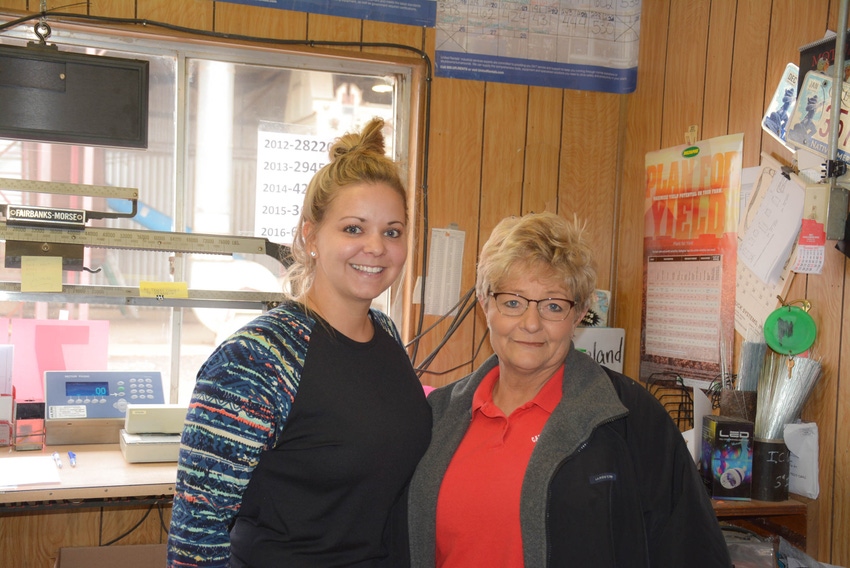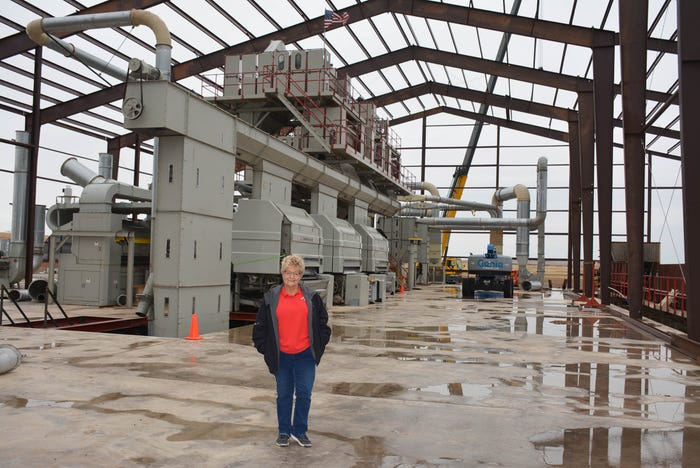
Carnegie Cooperative Gin is on the brink of celebrating its third record-breaking season since 2015, predicted to gin 120,000 bales this year—a feat that may have seemed unimaginable in the late 1990s when the Oklahoma facility ginned less than 1,000 bales and faced possible closure.
“It was very, very difficult. I mean it was a tough, tough time,” says Carnegie Gin manager Jeannie Hileman, who is in her 28th ginning season. “We were looking at the boll weevil program—at the time you couldn’t hardly grow a cotton crop because of the boll weevil. We could raise peanuts and corn. There were a lot of herbicides you could use on both, as far as taking care of your weeds. But there was nothing you could spray over the top of the cotton.”
But Hileman had the foresight to know that area cotton production was on the edge of a breakthrough, if the gin could just hold on. “We could see the Roundup Ready. We could see the Bollgard. And we could see those things in our immediate future. We were fixing to get rid of boll weevils, bollworms and weeds and we just didn’t believe we were going to be able to hold onto our cotton gin long enough for all of those things to happen.”

Carnegie Cotton Gin
So in 2002, Hileman and her board of directors approached the local Farmer’s Co-op Mill and Elevator. “At that time, there were two co-ops here in town. Our board was more interested in preserving the cotton gin, so we sold out for a very low price with the understanding that they keep the gin open for five years,” recalls Hileman. “So, if our speculations were wrong, they could close it. But if our speculations were right, they would have a reason to keep it. And definitely our speculations were correct because after ginning less than 1,000 bales, we ginned 60,000 last year. So it’s definitely proved to be a smart decision to keep a cotton gin in Carnegie.”
In 2002, after the only other gin in Carnegie closed, Hileman says they ginned 2,200 bales. By 2004, they were up to 8,000 bales, and, as she says, “there was no stopping us then.”
Cotton Career
Hileman’s career with Carnegie Gin began in 1990, when she accepted an invitation from Carnegie Gin board members to work as seasonal help, straightening out the farm records.
“I was doing farm bookkeeping for my husband and his brother,” says Hileman, who had always been a farmwife. “I had come down here for the season, and it seemed like a pretty natural fit, so I stayed on. The manager changed, and I stayed on as the office manager, and then as Freedom to Farm, boll weevils and the cotton acres continued to dwindle, the manager moved on. They made me manager. I was basically the sole employee at that time—manager, office, I was everything. That was in like 95-96.”
When asked what made her stay through those tough years, she replies, “I guess I’m not a quitter. I look back on it now, and wonder, ‘why did I do that?’ Part of the reason, I’m sure, is that this is my home town. I could see how quickly this could change. I really believed if we didn’t hang onto our gin that our producers were going to lose an opportunity to grow cotton if cotton came back.
“If you lose all of your infrastructure, you lose an opportunity. And that was just one more thing that I didn’t feel like we needed to lose.”
Hileman’s tenacity would be tested again during the 2011/2012 season. “It was the beginning of the God-awful drought. That drought wrecked our production in the state for nearly four years,” recalls Dr. Randy Boman, Oklahoma State University Extension state cotton lead, Altus, Oklahoma.
During those parched years, Boman says he began working with Hileman. “Her positive outlook and attitude is so infectious. She’s so positive and so energetic and such a big proponent of cotton that it’s amazing. I’ve always enjoyed going up there and working with that whole group of people because it’s kind of a new production area. They’re so hungry for information.”
Hydro, Okla., grower Merlin Schantz, echoes Boman’s sentiments about Hileman. “In the last 10 years, she has grown the cotton industry in this area phenomenally,” Schantz recalls. “2011/2012 tried pretty hard to take us out of the cotton business. Jeannie had worked really hard, and the dryland acres were slowly coming up in this area. Boy, and then I mean, 2011 and 12, just really cut the dryland acres back, and it’s just been in the last three years that we’re getting dryland acres back up.”
In fact, they have increased so much, Schantz isn’t sure where the ceiling is on the number of bales that could be ginned by Hileman and her crew. “She’s just a good promoter of the industry. And she’s managed that gin really well,” he says. “Her grades are good. She’s just played a really big role in seeing the cotton acres grow and expand. I don’t know how far it can go. But she went from 36,000 in 2015 to 61,000 in 2016.” And if she gins the predicted record bales for 2017, Schantz says, “that’s pretty phenomenal growth.”
See Record cotton yields spark record ginning season. http://bit.ly/2zXlnJQ
Carnegie History
Carnegie Gin was established in 1925. It was one of five gins in Carnegie. “Three of the four corners were cotton gins. It was a cotton town back then,” says Hileman. “I’ve got pictures that show on the west end of Main Street, the buyers would just set up, come in with their team, gin a bale, go around the back and pick it up and go downtown and sell it. “
In 1990, Oklahoma was home to 56 cotton gins. Today, only 15 remain. To keep up with increasing demand, Carnegie broke ground June 22, on a new $3.5 million gin north of Carnegie. Hopes are that the 45-per-bale-capacity gin will be up and running by Christmas.
“We’re pretty excited about getting it online,” says Hileman. “We feel like we’ll have it done by Christmas, so that will help us. We’ll run both of the gins at the same time.”
The gin was purchased and hauled from Mt. Olive, North Carolina. “This gin is a mirror image of what was in North Carolina,” says Carnegie ginner Dalton Skinner.

Carnegie Ginner Dalton Skinner with Carnegie Gin Manager Jeannie Hileman. Skinner watched the gin come down in Mt. Olive, North Carolina and is now working to make a mirror image of the gin in Canegie.
Increased capacity isn’t the only benefit of the new facility. “Right now our module yards are scattered all over the place. It’s difficult as far as getting our modules into town,” she explains. “I’ve got several different yards, one east, one south and one west. With the new gin, we’ll have 80 acres at the new plant and we’ll have our module yard all the way around it. I’ve got a burr stacker, so that will eliminate burr trucks. And I feel like anytime that you upgrade as far as technology, your grades will be better.”
While the current gin is located in the middle of town, relocation to the outside of the city limits will also benefit her small hometown. “I’m sure the city is going to be excited to get my dirt out of town. I’m within a city block of the hospital, the nursing home and downtown. I’m pretty sure they’ll be excited that my dirt’s a few miles from town.”
While Hileman says they’ll eventually close the old gin, “I think we’ll be far enough behind this year that we’ll continue to run it to catch up.”
Big Changes
Over her 28-year career, Hileman says the two biggest changes she’s seen have been in seed technology and harvesters.
“I used to sit here, and we sold chemical as well. I would sell semi-loads of insecticides trying to fight the boll weevil and the bollworm. And insecticide is a bad thing to put in the environment, but in order to grow a crop, you had to. You were fighting those boll weevils or bollworms, you were spraying at a 7-day interval or 10-day interval, whatever your consultant was telling you to. And there was just tons of these insecticides being sprayed,” she recalls. “And now with the new technology, we don’t have those issues. I think as far as, being able to grow a crop and protect the environment, that’s probably one of the biggest things. And of course with the herbicides, being able to spray over the top of the cotton and kill the weeds, that’s again one of the biggest changes.”

A new gin with a view...
The transformation in harvesting methods from rectangular cotton modules to round cotton bales also stands out. “The round bale is kind of crazy, as far as the way it has taken off. And the ability that those round bales have to preserve that cotton for months, and still open it up and it’s still like it was the day that you put it in there.
“It has given the producers the patience they need. When they feel like it’s [the cotton] deteriorating, their patience is not very good. But if they know it’s sitting there, and they know its ok, their patience is a little better for you,” she says laughing.
Family Affair
Managing at Carnegie has been a family affair. Sadie Hileman, Jeannie’s daughter, who recalls getting off the school bus at the gin, now serves as the office manager. Aaron Hileman, Jeannie’s son, worked with his mother in the gin, redoing the gin consoles and control panels. “I guess it’s kind of given the family an opportunity to work together,” she says. “Cotton has meant a lot my family.”
And no more so than in 2008 when her husband Randall was diagnosed with a lung disease and given months to live unless he received a transplant. “They told me he probably wouldn’t live 6 months, probably wouldn’t see my daughter [Sadie] graduate in May of 2009.”
To receive a transplant, Hileman’s husband and Sadie would have to move to St. Luis, where he would wait for a match, and that’s where Hileman’s cotton family stepped in. One of her farmers approached Monsanto and asked if they would donate Roundup. “And the farmers came in and bought this Roundup at a ridiculous price, three times or five times the price, at a fundraiser. And that pretty well paid for Randall and Sadie’s apartment we rented while we were up there,” she says. “Chemical companies bought airline tickets to send me back and forth, they did benefit dinners. It was just unbelievable.”
Once again, up against what seemed insurmountable odds, Hileman persevered. Her husband was matched with a donor and received his transplant. “They went up in July and got his lung transplant the first week in August, and they were home in November. A lot of people in that same complex had been waiting two years for a lung transplant and had not received a match.” She says Randal is doing great today.
As growers complete the 2017 season, Hileman and her crew will continue to gin this record crop while also building a new gin at the same time — not a tall order at all for a woman who knows adversity and victory all too well.

Hileman at the new gin. Hopes are to have it completed by Christmas.
About the Author(s)
You May Also Like






